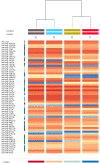Global microRNA expression profile in laryngeal carcinoma unveils new prognostic biomarkers and novel insights into field cancerization
- PMID: 36224266
- PMCID: PMC9556831
- DOI: 10.1038/s41598-022-20338-w
Global microRNA expression profile in laryngeal carcinoma unveils new prognostic biomarkers and novel insights into field cancerization
Abstract
Laryngeal carcinoma is still a worldwide burden that has shown no significant improvement during the last few decades regarding definitive treatment strategies. The lack of suitable biomarkers for personalized treatment protocols and delineating field cancerization prevents further progress in clinical outcomes. In the light of this perspective, MicroRNAs could be promising biomarkers both in terms of diagnostic and prognostic value. The aim of this prospective study is to find strong prognostic microRNA biomarkers for advanced laryngeal carcinoma and molecular signatures of field cancerization. Sixty patients were enrolled and four samples were collected from each patient: tumor surface and depth, peritumor normal mucosa, and control distant laryngeal mucosa. Initially, a global microRNA profile was conducted in twelve patients from the whole cohort and subsequently, we validated a selected group of 12 microRNAs with RT-qPCR. The follow-up period was 24 months (SD ± 13 months). Microarray expression profile revealed 59 dysregulated microRNAs. The validated expression levels of miR-93-5p (χ2(2) = 4.68, log-rank p = 0.03), miR-144-3p (χ2(2) = 4.53, log-rank p = 0.03) and miR-210-3p (χ2(2) = 4.53, log-rank p = 0.03) in tumor samples exhibited strong association with recurrence-free survival as higher expression levels of these genes predict worse outcome. Tumor suppressor genes miR-144-3p (mean rank 1.58 vs 2.14 vs 2.29, p = 0.000) and miR-145-5p (mean rank 1.57 vs 2.15 vs 2.28, p = 0.000) were significantly dysregulated in peritumor mucosa with a pattern of expression consistent with paired tumor samples thus revealing a signature of field cancerization in laryngeal carcinoma. Additionally, miR-1260b, miR-21-3p, miR-31-3p and miR-31-5p were strongly associated with tumor grade. Our study reports the first global microRNA profile specifically in advanced laryngeal carcinoma that includes survival analysis and investigates the molecular signature of field cancerization. We report two strong biomarkers of field cancerization and three predictors for recurrence in advance stage laryngeal cancer.
© 2022. The Author(s).
Conflict of interest statement
The authors declare no competing interests.
Figures





Similar articles
-
Proangiogenic signature in advanced laryngeal carcinoma after microRNA expression profiling.Mol Biol Rep. 2020 Jul;47(7):5651-5655. doi: 10.1007/s11033-020-05250-8. Epub 2020 Jun 12. Mol Biol Rep. 2020. PMID: 32533400
-
Downregulation of miR-29c-3p is associated with a poor prognosis in patients with laryngeal squamous cell carcinoma.Diagn Pathol. 2019 Oct 15;14(1):109. doi: 10.1186/s13000-019-0893-2. Diagn Pathol. 2019. PMID: 31615536 Free PMC article.
-
New miRNA expression abnormalities in laryngeal squamous cell carcinoma.Cancer Biomark. 2016;16(4):559-68. doi: 10.3233/CBM-160598. Cancer Biomark. 2016. PMID: 27002759
-
Primary tumor microRNA signature predicts recurrence and survival in patients with locally advanced esophageal adenocarcinoma.Oncotarget. 2016 Dec 6;7(49):81281-81291. doi: 10.18632/oncotarget.12832. Oncotarget. 2016. PMID: 27793030 Free PMC article. Review.
-
Identification of differentially expressed circulating serum microRNA for the diagnosis and prognosis of Indian non-small cell lung cancer patients.Curr Probl Cancer. 2020 Aug;44(4):100540. doi: 10.1016/j.currproblcancer.2020.100540. Epub 2020 Jan 23. Curr Probl Cancer. 2020. PMID: 32007320 Review.
Cited by
-
A Critical Review on microRNAs as Prognostic Biomarkers in Laryngeal Carcinoma.Int J Mol Sci. 2024 Dec 16;25(24):13468. doi: 10.3390/ijms252413468. Int J Mol Sci. 2024. PMID: 39769234 Free PMC article. Review.
-
Peritumor Mucosa in Advanced Laryngeal Carcinoma Exhibits an Aberrant Proangiogenic Signature Distinctive from the Expression Pattern in Adjacent Tumor Tissue.Cells. 2024 Apr 5;13(7):633. doi: 10.3390/cells13070633. Cells. 2024. PMID: 38607072 Free PMC article.
-
Diagnostic and Prognostic Value of microRNAs in Patients with Laryngeal Cancer: A Systematic Review.Noncoding RNA. 2023 Jan 19;9(1):9. doi: 10.3390/ncrna9010009. Noncoding RNA. 2023. PMID: 36827542 Free PMC article. Review.
-
Co-expression of miRNA players in advanced laryngeal carcinoma - Insights into the roles of miR-93-5p, miR-145-5p, and miR-210-3p.Biomol Biomed. 2025 Apr 3;25(5):1052-1062. doi: 10.17305/bb.2024.10947. Biomol Biomed. 2025. PMID: 39412136 Free PMC article.
References
Publication types
MeSH terms
Substances
LinkOut - more resources
Full Text Sources

